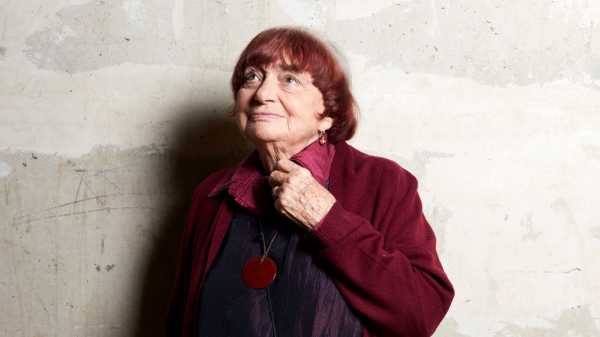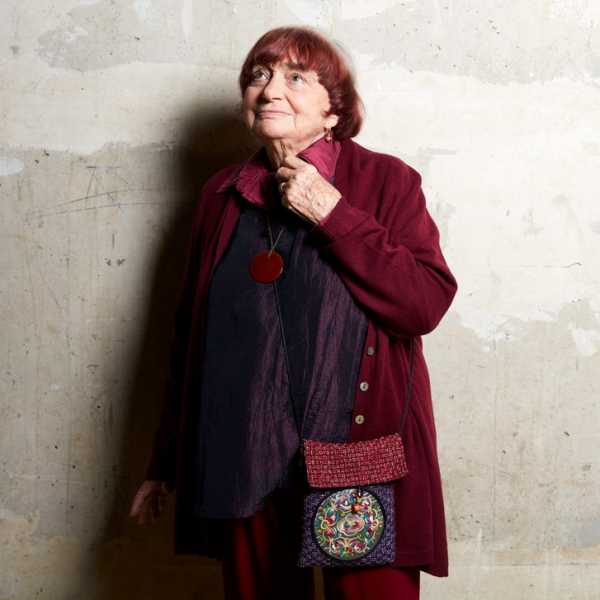

Agnès Varda was known as the Godmother of French New Wave cinema, but she charted a course unlike any other. Her wave was her own.
Paul Grandsard / Anzenberger / Redux
Agnès Varda liked blunt endings. Her films don’t wind down, or build to a grand finale. They simply stop—cut!—like a held breath. That was what it felt like, on Friday, to wake up to the news that Varda had died at the age of ninety: a sudden shock, a rupture without needless preamble or false ceremony. For all her accumulated decades, Varda had come to seem ageless, like the storybook character that she resembled—the round, little old lady with the two-tone pageboy haircut and the polka-dot tunics, the thin, quizzical mouth and the saucer eyes. Boosted by the acclaim that greeted “Faces Places,” the film that she made, in 2017, with the artist JR, she enjoyed the best kind of late-in-life celebrity, admired, appreciated, and adored. She modelled for the cover of The Gentlewoman in the same rose-print Gucci pajama top that she wore to the Oscars, and attended a retrospective of her films at the Cinémathèque Française. Varda had always been quick to adopt new technology—the advent of cheap, portable digital cameras, in the early two-thousands, heralded her remarkably fruitful late period, in which she made some of the most inventive and humane documentaries of her, or anyone else’s, career—and it was a treat to follow her on Instagram, where she posted stills from her films alongside a range of whimsical selfies. Even though she was winding down her filmmaking career, it is hard to believe that those delightful digital postcards will now stop arriving, too.
Varda has long been called the Godmother of the French New Wave; when she made her first two films, “La Pointe Courte,” in 1955, at the age of twenty-six, and “Cleo from 5 to 7,” in 1961, both considered proto-examples of the movement, she effectively wrote the headline of her obituary. The truth is that, in more than sixty years of filmmaking, she charted a course unlike any other. Her wave was her own. Female artists of Varda’s generation, discounted or marginalized in their lifetimes, are often in the position of being “rediscovered” years later, long after they can enjoy the recognition. Varda lived long enough to see herself celebrated as the feminist lodestar she was by generations of younger women, though she was not entirely satisfied with this distinction. At an awards ceremony in 2017, in which she was presented with an honorary Oscar for lifetime achievement, Varda thanked the four women who had given her a glowing introduction, before quipping, “I have a little question: Are there no men in this room who love me?”
One of the things that is so moving and exciting about Varda’s way of making films is how transparent she made her own fanciful, critical, witty process of looking. Even more than other filmmakers, she made the camera her eye—searching, zooming, lingering on the sorts of things that other people might see as part of the background, if at all. In “Les Dites Cariatides,” a short film that Varda released in 1984, she walks the streets of Paris, looking up for the city’s caryatids, stone sculptures of nude women gorgeously imprisoned in the city’s grandest buildings, and caresses their immobilized bodies and faces with her lens. “The nude, in the street, is more often made of bronze than human skin,” she says, in voice-over—and more often female than male, a point that she makes by filming a naked man walking calmly down a Parisian street in broad daylight. Last year, while at Harvard to give two Norton Lectures on her work, Varda told the audience that she often felt like she was drawing with her camera, particularly when she was shooting women. “I filmed the line of her body starting with her feet,” she said, of Jane Birkin, the subject of her film “Jane B. par Agnes V.” She had no use for the usual cinematic vocabulary of sexualized female bodies, she said, women cut up into parts for the viewer’s ease and pleasure. “I like to feel that women have a full body, which can be shown in integrity,” she said.
Varda knew how to wait, and how to listen. One of the main experiences of “Daguerréotypes,” a film that she made in 1975, about her Parisian street, the Rue Daguerre, is of silence and pause: the interstitial quiet of a housewife waiting at the butcher shop for her meat to be wrapped up, or of a shopkeeper taking his time finding a perfume on a shelf. It is a sound that has vanished from our world, the accompaniment to the sort of laden, in-between time that we have learned to consider an inconvenience or an annoyance and to stamp out with distraction. It is a beautiful, unselfconscious sound. She might have cut it out. But she kept it in. She also knew how to invent, to add magic to the ordinary. In a scene from “The Beaches of Agnès,” the autobiographical self-portrait that she made, ten years ago, at the age of eighty, acrobats at an impromptu circus that she has staged by the sea flip and fly through the air like fish. They serve no narrative purpose; there is no reason for them to be there, aside from the joy they give us. “That’s one side of the cinema I love: to get money to make dreams,” she said.
She called her style of filmmaking cinécriture, or “cinewriting.” Her films, which celebrate the art of the foraged and the found, can be like associative essays, or like poems. “Writing a grocery shopping list before going to the market is a poem to me,” Varda said, at Harvard. So was filming fisherman speaking about their nets at Noirmoutier, the French island where she and her husband, Jacques Demy, had a house. So was a list of forty-six potato varietals, which Varda read out in a jaunty patter. She discovered her affinity for “the most modest vegetable” while shooting “The Gleaners and I,” her documentary, from 2000, about people in France who survive by gathering food that others forget or discard. It is a sort of companion piece to “Faces Places,” in which Varda and JR tour the country, filming the sorts of ordinary people who would never expect to become the subject of a film. “We were making something that is very important for me now, the ephemeral,” she said. “Life is short, the ephemeral is everywhere, so we go on making art.”
After Varda’s Harvard lecture, she sat backstage with me for an interview, resting her feet, and talked, in the roving, associative way of her films, about her work. (“Varda by Agnès,” Varda’s final film, which has been released in France, will cover some of the same autobiographical territory that she addressed in her talk.) There is a scene in “Faces Places” in which she and JR visit two goat-farmers, one who clips the horns of his animals and one who doesn’t. The film subtly takes the side of the non-clipper, and so the other farmer had written her a letter, complaining that he looks bad by comparison. “Well, it’s a problem of integrity, and of beauty—the integrity and beauty of animals,” she said. “We mistreat animals to have a bit more space to keep more of them in, to get three more liters of milk, and four additional cheeses. Production has become more important than life. It’s not a question of saving animals—I mean, sure, I want Bardot”—as in Brigitte, the onetime bombshell, now animal-rights activist—“to save them, but that’s not it. It’s about the idea of whether we can leave them their proper form, their integrity.”
Could a movie help solve this problem of production, our human obsession with tailoring the whole known world to our own convenience? Maybe not, but Varda’s own interest in human excess and wastefulness had already had some appreciable effect. “People tell me that after seeing ‘The Gleaners and I,’ they started paying attention,” she said. “They’ve started tasting yogurt before they throw it away. They’re starting to use their senses, and their minds.” One thing in particular pleased her. “Before, people would tell their kids to say hello to postal workers. So, I said to them, ‘Now you have to teach them to say hello to garbage collectors!’ And they said they’d never thought of that before. Because to be a postal worker is lovely, and to be a garbage collector is less lovely. But they’re people, too.”
Varda identified with the misshapen potato, and with the gleaner who picks it up from the ground. She made an art of memory without nostalgia. At the end of “The Beaches of Agnès,” Varda sits in the courtyard of her house in Paris, surrounded by brooms, which her friends brought, as gifts, to celebrate her birthday the day before. She holds a picture frame, in which her image is projected; the camera zooms out to show another frame and another in a mise en abyme. “It all happened yesterday, and it’s already in the past,” Varda says. “A sensation combined instantly with the image, which will remain. While I live, I remember.” Now she is gone, and that job passes to us.
Sourse: newyorker.com






